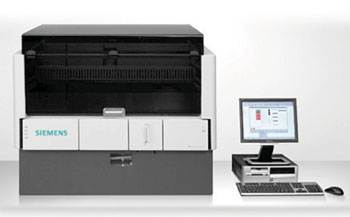Test Predicts Death in Patients with Serious Liver Disease
By LabMedica International staff writers
Posted on 12 Apr 2016
Acute-on-chronic liver failure (ACLF) is a sudden deterioration of the liver function in a patient with liver cirrhosis accompanied by failure of one or more organ systems and this liver disease has a serious prognosis and the four-week mortality rate is 20% to 30%.Posted on 12 Apr 2016
This condition is often triggered by an infection, bleeding or other stressful events and due to the severity of the disease it is important to develop a test to identify patients with the highest risk of developing this condition and thus the highest risk of a fatal outcome.

Image: The BEP 2000 Advance System fully automated microtitration plate (MTP) analyzer (Photo courtesy of Siemens).
Scientists at Aarhus University (Denmark) screened patients at liver units in 29 university hospitals with a diagnosis of cirrhosis based on previous liver biopsy findings or a composite of clinical signs and findings provided by laboratory test results, endoscopy, and radiologic imaging. Eighty-six cirrhosis patients had no ascites and no ACLF, 580 had ascites but no ACLF; 100, 66, and 19 had ACLF-grade-I (ACLF-I), ACLF-II, and ACLF-III, respectively.
The scientists measured the circulating macrophage activation markers soluble sCD163 and mannose receptor (sMR) and related them to the short-(one to three months) and long-term (6 months) mortality in the cirrhosis patients. The plasma concentration of sCD163 was determined in duplicate in samples that had been frozen at -80 °C by an in-house sandwich enzyme-linked immunosorbent assay (ELISA) using a BEP-2000 ELISA-analyzer (Dade Behring, Deerfield, IL, USA). The team measured sMR by a newly developed in-house ELISA assay.
The investigators found a stepwise increase in median sCD163: 5.68; 8.26; 9.50; 15.68; 20.18 mg/L, and sMR: 0.60; 0.81; 1.17; 1.41mg/L with increasing grades of ACLF. Both sCD163 and sMR were independently associated with short and long-term mortality and showed equal or higher predictive accuracy than MELD, CLIF-C ACLF and CLIF-C AD scores. Addition of the macrophage markers to the clinical scores improved the prognostic efficacy. In ACLF patients sCD163 improved prediction of short-term mortality and in patients without ACLF sMR improved prediction of long-term mortality.
The authors concluded that the severity related increase in sCD163 and sMR and close association with mortality suggest a primary importance of inflammatory activation of liver macrophages in the emergence and course of ACLF. The study was published in the April 2016 issue of the Journal of Hepatology.
Related Links:
Aarhus University
Dade Behring














